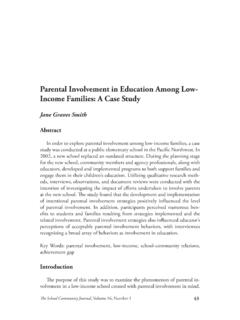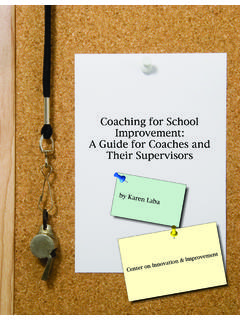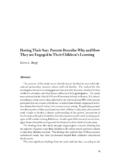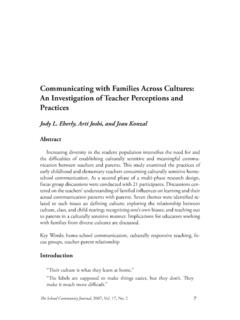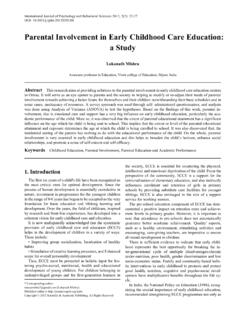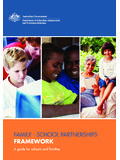Transcription of Facilitating Family Involvement and Support for …
1 53 The School Community Journal, 2008, Vol. 18, No. 2 Facilitating Family Involvement and Support for Inclusive EducationYaoying Xu and John Filler Abstract The advantages to a Family -centered approach to services have been em-phasized in education literature for several decades. Active Family Involvement and Support have been identified as key elements to the success of inclusive early childhood education programs. The purpose of this article is two-fold: to review literature on Family Involvement in inclusive early childhood pro-grams from the perspective of developmental ecological systems theory, and to describe Family -focused programs for developing embedded learning opportu-nities across multiple inclusive settings.
2 In so doing, we discuss how the four components of the ecological system (the microsystem, parents and siblings; the mesosystem, peers and school; the exosystem, community connections; and the macrosystem, cultural identity) influence the education of the child. Key words: Family Involvement , inclusion, ecological systems, parents, siblings, early childhood education, Asian, case, cultural diversityIntroductionActive Family Involvement has long been considered to be an important factor related to better outcomes in the education of young children with and without disabilities in inclusive early childhood programs (Berger, 1995; Levy, Kim, & Olive, 2006; P rez Carre n, Drake, & Barton, 2005).
3 Research has shown that high levels of parental Involvement correlate with improved aca-demic performance, higher test scores, more positive attitudes toward school, THE SCHOOL COMMUNITY JOURNAL54higher homework completion rates, fewer placements in special education, ac-ademic perseverance, lower dropout rates, and fewer suspensions (Christenson, Hurley, Sheridan, & Fenstermacher, 1997; Hoover-Dempsey & Sandler, 1997; P rez Carre n, et al.). Parental Involvement is important for the education of children of all ages, but it is critical for the success of young children in inclusive settings (Filler & Xu, 2006).
4 Although there has not been a standard definition of the term inclusion, inclusive early childhood programming typically reflects three char-acteristics: (1) full participation of children with disabilities in everyday life activities with their typically developing peers in both school and community settings; (2) educational goals and objectives are developed and implemented through team collaboration by parents and professionals; and (3) child out-comes are measured periodically to ensure the effectiveness of the program (Guralnick, 2001; Hunt, Soto, Maier, Liboiron, & Bae, 2004; Odom et al.)
5 , 1996; Siegel, 1996). The recognition that Family Involvement benefits children does not make clear how the Involvement becomes a positive force or what factors act to de-termine the degree of benefit. Family Involvement is not a fixed event but a dynamic and ever-changing series of interactions that vary depending on the context in which they occur, the disciplines from which the collaborative team members are drawn, the resources parents bring to the interactions, and the particular needs of the child and the Family . Traditionally, the education agency or school has created structures and activities intended to Support Involvement .
6 However, as parents become involved, they do so with limited power to define their roles and actions (Fine, 1993). They are often expected to agree with and Support the structures and dynamics already in place. Parents who agree with the school and get along with the existing model are seen as good. Those who disagree are considered problematic (Lareau & Horvat, 1999). Parent Involvement is also related to teacher actions. For example, Ander-son and Minke (2007) found that specific teacher invitations were significantly related to parent Involvement behaviors, particularly among minority and low-income families.
7 They suggested that when parents perceived that their participation was desired by teachers, they would often overcome obstacles to be involved in spite of a lack of resources. Brown and Medway (2007) exam-ined the relationships among measures of school climate, teacher expectations, and instructional practices in an elementary school with a high percentage of low-income, minority children. They found that when teachers valued paren-tal input and Family Involvement , they created ways to facilitate home-school communication. Exemplary teachers also felt responsible for building a posi-tive relationship with parents and placed a high value on parents helping their Family Involvement & INCLUSION55children with homework and other activities.
8 These teachers viewed parent in-volvement as more than physical presence at school and felt that parents could make a significant educational impact beyond what they may contribute by attending meetings and volunteering in the classroom. The purpose of this article is two-fold: to review literature on Family Involvement in inclusive early childhood programs from the perspective of de-velopmental ecological systems theory, and to describe Family -focused programs for developing embedded learning opportunities across multiple inclusive set-tings. We begin the review with a discussion of four ecological systems that are critical to an understanding of factors that may influence the degree and form of participation and then go on to describe a slightly different but compli-mentary approach that views the child as embedded in a series of interrelated systems that interact with one another.
9 The Theoretical Framework: Developmental Ecological Systems ApproachThe ecological systems model we are focusing upon is based on an approach first described by Urie Bronfenbrenner (1988, 1989; Bronfenbrenner & Mor-ris, 1998). According to Bronfenbrenner, an ecological systems model views the child as existing within a complex ecological context consisting of numer-ous intrafamilial and extrafamilial systems that affect children s development. Specifically, there are four interconnected systems that comprise the model (see Figure 1). The first is the microsystem and consists of the immediate fam-ily environment or setting in which the child lives, such as parent and sibling interactions that exert an impact on the child.
10 The mesosystem refers to inter-connections between two or more settings or the interactions outside the Family environment such as school and peer influences. The exosystem is the commu-nity context that may not be directly experienced by the child, but which may influence the elements of the microsystem, such as sibling interactions. The macrosystem is the wider social, cultural, and legal context that encompasses all the other systems. An ecological systems view of inclusive education sug-gests that children with or without disabilities develop in a complex social world and that it is necessary to observe interactions at multilevel contexts and examine changes over time at all levels.
